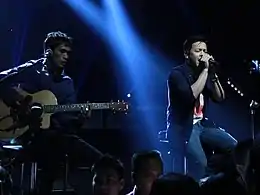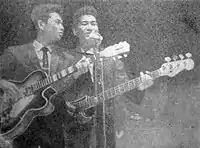Indo pop
Indo-pop (Indonesian: Pop Indo) also known as Indonesian pop or I-pop is loosely defined as Indonesian pop music; however, in a wider sense it can also encompass Indonesian pop culture, which also includes Indonesian cinema and sinetrons (Indonesian TV drama).
| Indonesian pop | |
|---|---|
| Other names | I-pop |
| Stylistic origins | |
| Cultural origins | 1960s, Indonesia |
| Typical instruments | Vocal, acoustic guitar, electric bass, electric guitar, drum, keyboard, piano, violin, harmonica, synthesizer, ukulele |
| Subgenres | |
| Pop Melayu | |
| Regional scenes | |
| |
| Other topics | |

Indonesian pop music today is sometimes influenced by trends and recordings from Western music.[1] However, in return the Indonesian style of pop music has influenced the regional pop culture in Southeast Asia, especially the Malaysian pop scene that began to imitating the Indonesian style of pop music in late 2000s. Indo pop usually expresses contemporary Indonesian sentiments and lifestyles, generally about love and social life related to relationships. Indonesian-pop music with sad and mellow melodies is also very popular and selling very well.[2]
History
1960s - 1990s

Koes Plus, formerly called Koes Bersaudara, is considered one of the pioneers of Indonesian pop and rock 'n roll music in the 1960s and 1970s. The American and British music influences were obvious in the music of Koes Plus; the Beatles were known to be the main influences of this band.
Indonesian pop music in the 1970s also gave rise to musicians and singers such as Chrisye, Titiek Puspa, and Ebiet G. Ade. Their work in the country's music industry was very large and influenced the development of music after that. These names are still stuck in the minds of many people because they are the pioneers of pop music in this country.[3]
The Indonesian music industry in the 1970s was quite advanced where the pop music genre became very popular, presenting works from musicians from Chrisye, Ade and Puspa. Prambors (LCLR) songwriting competition in 1977 was a breaker of stagnation in the pop music industry at that time. This event also gave birth to many new musicians in the following years.[3]

Entering the decade of the 80s and 90s, musicians appeared; Iwan Fals was very popular at that time, the music still a favorite of many people now. The songs are quite political; the music raises many issues such as war (Puing), the environment (Isi Rimba Tak Ada Tempat Berpijak Lagi), poverty (Siang Sebrang Istana), child labor (Sore Tugu Pancoran). Because the songs are political and criticize the government a lot. Some of his songs were banned by the authoritarian Suharto government at that time.[4]
In the late 80s, boy bands and girl bands began to emerge. The first boyband to debut in Indonesia was Trio Libels, which debuted in the late 1980s. This was followed by the first wave or generation of boybands and girlbands, and several notable groups that emerged from this wave are Cool Colors, Coboy, ME, T-Five, Warna, Rida Sita Dewi, AB Three, and Bening.[5]
2000s - 2010s
In 2000s, music with a pop rock style began to dominate the national music charts. The popular bands that use pop rock concept include Peterpan, Dewa 19, Gigi, Sheila on 7, Padi, Ada Band, Ungu, Letto, Nidji, and D'Masiv. All of which are featured on MTV Asia and tour regularly nationwide plus the neighbouring countries of Singapore and Malaysia. These bands have received immense reception in the region (including Brunei), some people have attributed this to the neutral shared vocabulary in songwriting compared to the spoken vernaculars spoken between these countries while some have speculated on the proliferation of pirated cassettes and CDs being the cause.[6][7]
The popularity of Indonesian music in Malaysia in particular had become so overwhelming that in 2008, demands had been made for radio stations there to restrict the number of Indonesian songs being aired so local musicians would be given a fairer chance.[8]
Some of these pop rock bands incorporate traditional Malay roots into their sound, reviving the old Orkes Melayu style once popular in the region across Indonesia and Malaysia. Such bands belong to the "Band Pop Melayu" Malay Pop subgenre which became popular in late 2000s with acts like Kangen Band, Wali, Hijau Daun, Armada, Angkasa and ST 12.[9]
Indonesia first experienced the Korean wave in the 2000s, leading to the popularization of K-dramas and K-pop. The rising popularity of K-pop gave rise to a second wave or generation of boybands and girlbands in Indonesia.[10][11] There are several K-pop influenced groups that emerged from this wave, one of the earliest being G-String,[12] but the most notable are SM*SH, CJR and Cherrybelle. Other popular groups include 7Icons, XO-IX, Hitz, and Dragonboyz. It is from this era that the term "I-pop" emerged and was used by several groups including Cherrybelle,[13][14] 7Icons, and XO-IX.[15]
Several J-pop influenced groups also debuted around the same time. In 2011, Super Girlies, a J-pop influenced girlband, debuted; their first single is a cover of a Berryz Kobo song.[16] In the same year, Japanese idol group AKB48 launched its first sister group in Jakarta, JKT48. JKT48 introduced the "idols you can meet" concept in Indonesia, and distinguished itself from other groups by calling themselves an idol group, rather than a "girlband" particularly.[17] Subsequently, several independent J-pop influenced "idol groups" made their debuts, including LuSca, which debuted in 2012.[18]
Connection with Indonesian films
Indonesian films have a strong relationship with Indonesian music. Most Indonesian films feature soundtracks consisting primarily of Indonesian music, generally Indonesian pop and some rock.
Melly Goeslaw is an Indonesian musician and female solo singer, known for her many musical works related to soundtracks in Indonesian films. Melly made her debut in making soundtracks for teen drama films in 2002 with the film entitled Ada Apa dengan Cinta?, where most of the songs were sung by her and written by her and her husband.[19]
Melly Goeslaw then provided the soundtrack for the film Eiffel I'm in Love in 2003, the film Apa Artinya Cinta? in 2005, the film Heart in 2006, the film The Butterfly in 2007, and the film Ketika Cinta Bertasbih in 2009.[20] She considered writing the song Ketika Cinta Bertasbih more difficult than his previous work in youth romantic films, because it is a religious film. Therefore, she felt she had to be extra careful.[21]
Her works in these film made Melly increasingly popular as a soundtrack musician, so she was also given the nickname Queen of Soundtrack. The soundtrack later won Best Soundtrack at the Indonesian Film Festival.[22]
International popularity
The high popularity of Indonesian pop music is now limited to Malay-speaking countries. The wider coverage is only ASEAN countries such as the Philippines, Vietnam and Cambodia.[23]
Indonesian singers such as Agnez Mo have been gaining popularity in neighbouring Asian countries such as Malaysia, Singapore, Vietnam, Sri Lanka, Cambodia and the Philippines.[24]
.jpg.webp)
The 2018 single, "Heaven" recorded by Afgan, Isyana Sarasvati and Rendy Pandugo, became popular not only in Indonesia, but also in Taiwan, Vietnam and Sri Lanka, reaching the top 10 in all four countries.[25]
In 2018, during the Asian Games, the official theme song "Meraih Bintang", performed by pop dangdut singer Via Vallen[26] became viral in numerous countries across Asia and beyond; with many singers performing translated covers of the song in their respective languages and uploading the videos on YouTube.
Nevertheless, prominent Indonesian musicians such as Rich Brian, NIKI, Stephanie Poetri, Weird Genius, and Rainych have acquired recognition internationally between 2018 and 2022. They are primarily associated with international record labels and represent the rise of Indo pop in international popularity.
See also
References
- "Indonesian Pop Music". National Geographic. Archived from the original on 2011-01-04. Retrieved 2011-05-25.
- "Orang Indonesia Cenderung Mempunyai Selera Musik Sedih". Prambors FM. 2022-06-02. Retrieved 2022-08-25.
- "Semua Halaman - Tren dan Warna Musik Indonesia Dekade 1970-an Sampai 2010-an". JawaPos.com (in Indonesian). 2021-03-10. Retrieved 2022-08-27.
- Elliot (2018-10-16). "Traditional and Modern Indonesian Music". Retrieved 2022-08-27.
- "Kapanlagi.com: Musik - 10 Boyband dan Girlband Indonesia Yang Pernah Jaya di Era 90-an". KapanLagi.com (in Indonesian). Retrieved 2022-09-25.
- "10 Lagu Indonesia Tahun 2000-an yang Intronya Bikin Flashback ke Era MTV - Kapanlagi.com". www.kapanlagi.com. Retrieved 2023-09-25.
- "Kapanlagi.com: Musik - 8 Musisi Jagoan Indonesia Yang Berjaya di Malaysia". KapanLagi.com (in Indonesian). Retrieved 2023-09-25.
- "Malaysian music industry wants Indonesian songs restricted". The Jakarta Post. 3 September 2008. Archived from the original on 24 December 2009.
- “Goodcommerce”. "HIDUP MATI MUSIK POP MELAYU DI INDONESIA DARI NORAK SAMPAI DIJADIKAN AJANG UNTUK BERNOSTALGIA". www.froyonion.com. Retrieved 2023-09-25.
- Bennett, A.; Robards, B. (2014-06-15). Mediated Youth Cultures: The Internet, Belonging and New Cultural Configurations. Springer. ISBN 978-1-137-28702-1.
- Kerr, Thor; Ndimande, Bekisizwe; Putten, Jan Van der; Johnson-Mardones, Daniel F.; Arimbi, Diah Ariani; Amalia, Yuni Sari (2018-12-14). Urban Studies: Border and Mobility: Proceedings of the 4th International Conference on Urban Studies (ICUS 2017), December 8-9, 2017, Universitas Airlangga, Surabaya, Indonesia. Routledge. ISBN 978-0-429-01724-7.
- Times, I. D. N.; Triadanti. "Apa Kabar Boyband dan Girlband yang Pernah Menjamur di Indonesia?". IDN Times (in Indonesian). Retrieved 2022-09-24.
- "Kapanlagi.com: Musik - Dianggap Tiru Konsep Girlband Korea, Cherry Belle: Salah Banget!". KapanLagi.com. Retrieved 2022-09-24.
- Coley, Denise (2015-05-22). "Non-Kpop Wednesday: Cherrybelle". K Crush America Magazine. Retrieved 2022-09-24.
- Selasa, 10 Januari 2012 21:43 Penulis: Arai Amelya. "'K-Pop vs I-Pop', N: Sonic Siap 'Lawan' Boyband Indonesia". KapanLagi.com. Retrieved 2022-09-24.
- Okezone (2012-01-29). "Supergirlies Beli Lagu dari Girlband Jepang : Okezone Celebrity". celebrity.okezone.com/ (in Indonesian). Retrieved 2022-11-16.
- "Ngobrol Bareng Anji Manji, Personil JKT48 Tak Mau Grupnya Disebut Girlband, Kenapa?". Grid.ID (in Indonesian). Retrieved 2022-11-16.
- You, Mas Joy-Japan On (2014-10-06). "[Local Idol] Yuk kita mengenal lebih dekat dengan Lumina Scarlet!". Japanese Station (in Indonesian). Retrieved 2022-11-17.
- Media, Kompas Cyber (2020-11-16). "Melly Goeslaw Sebut Ada Apa Dengan Cinta Jadi Titik Penting Kariernya". KOMPAS.com (in Indonesian). Retrieved 2023-09-25.
- "First Solo Concert For Melly Goeslaw | The Jakarta Globe". 2012-09-28. Archived from the original on 2012-09-28. Retrieved 2023-09-25.
- "Melly finds writing religious songs hard". The Jakarta Post. Retrieved 2023-09-25.
- "'Arisan' takes major honors at film festival | The Jakarta Post". 2012-10-15. Archived from the original on 2012-10-15. Retrieved 2023-09-25.
- "Editor Says: Ketika Musik Indonesia Berjaya di Negeri Tetangga". fimela.com (in Indonesian). Retrieved 2023-01-23.
- "Agnez Mo Buktikan Kedahsyatan Suaranya saat Nyanyikan Lagu Ini, Netizen: Itu Berkat Soundman".
- "Afgan Gembira Lagunya Bersama Isyana dan Randy Pandugo Diminati". 30 April 2018.
- Putra, Muhammad Andika (7 June 2018). "Via Vallen Bakar Semangat Asian Games lewat "Meraih Bintang"" [Via Vallen keep Asian Games spirit through "Meraih Bintang"]. CNN Indonesia (in Indonesian). Retrieved 18 June 2018.